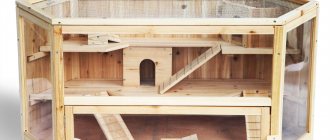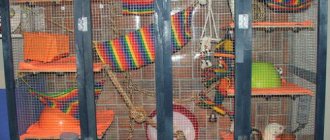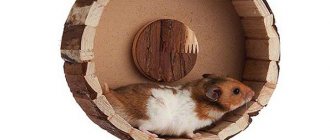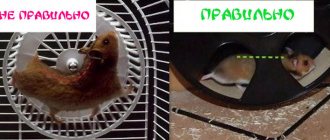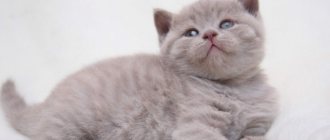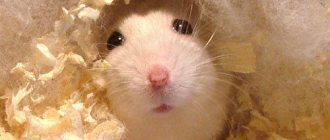Many pet lovers on forums urge that owners not buy balls for their rodents without any holes, why?
There must be good air circulation in the spheres
A walk is a full-fledged load on the hamster, so good air circulation in the sphere is necessary, otherwise the animal will experience discomfort and possibly even suffocate. The presence of many holes for ventilation is one of the guarantors of safety for the pet’s health.
When you make a walking sphere, do not forget about ventilation!
The better light transmission the material has, the easier it will be for the hamster to navigate the surrounding space; if the ball is too dark, then walking for the animal will resemble walking in a dark room; it is unlikely that it will appreciate such entertainment.
It is best to choose a ball of light colors to make it easier for your pet to navigate the space.
The color itself should not be very bright; it would be best to choose a completely transparent material, but pastel colors may also be suitable. In addition, it is in these balloons that you will be able to take funny photos of your pet.
DIY ball
Now you know everything about the details of the device, let's move directly to the topic of how to make a walking ball for a hamster with your own hands. In fact, it is not as difficult as it might seem at first glance.
You can try making a hamster ball with your own hands
If you notice that the animal is not very happy to walk in such a device, do not force it, maybe it’s just not used to this, or maybe it doesn’t like the ball. If the latter, then don’t be upset, try making another sphere or pick it up at a pet store.
From a plastic bottle
This is the simplest and most popular method of making balls with your own hands. Let's move on to the manufacturing technique:
- Find a transparent plastic bottle with a sufficiently large diameter and a wide neck (milk bottles are often used, but it is not a fact that they will suit your animal, check the fact).
- Make sure that you can make ventilation holes in such plastic and practice on unnecessary bottles in advance.
- If your trial attempts at cutting out the vents are successful, move on to the main bottle. If you have the necessary tools, you can try making a couple of holes in the bottle cap, it really won't make much of an improvement, so these are more for your peace of mind.
- When everything is ready, all that remains is to not make the hamster immediately want to run away at the sight of the toy; we’ll talk about this in more detail in the section “teaching the hamster to use the ball.”
The simplest and most popular method of making a ball
From the bucket
Another option for making a walking sphere is from a bucket. This method is somewhat more difficult to implement, but in a small bucket the hamster will have more room than in a bottle. The difficulty is that the plastic used to make the buckets is thicker and stronger, most likely you will need some skills in using construction tools.
The action plan is as follows:
- Find a transparent plastic bucket that is the right size for your rodent, you can look at the container for cotton candy, mayonnaise or something else, but be sure to rinse it well, the hamster may refuse to approach the ball because of the odors.
- Make ventilation holes; you will need to choose tools depending on the thickness of the plastic; if it is very strong and dense and there is no other option, try using a drill. If you are not sure that you can cope with it, do not take risks, ask others to help.
- When you have cut out all the ventilation holes, evaluate the weight of the product, whether the hamster can move comfortably in it, and then present your work to the animal.
- Be careful with the lid, if it is too easy to open, keep an eye on the hamster while walking, as finding a little deserter in the apartment will not be the easiest thing.
You can make a ball using a plastic bucket
Making a training device from a plastic bottle
When choosing plastic containers, you need to consider several important points.
- The neck should be wide enough for the hamster to fit into.
- It is better to choose a bottle that contains food products. It is important that it does not previously contain toxic substances.
The manufacturing process is extremely simple. You should prepare two identical containers with a wide neck, preferably made of transparent plastic. Both bottles need to be cut off at the top so that when joined together they resemble a ball or ellipse.
It is necessary to clean the edges well, smoothing out the sharp structure. If this doesn’t work, you can briefly lean them against a hot iron - slightly melting, the edges will become safer.
At the next stage, holes are made for air circulation. To do this, make as many holes as possible in the two covers of the structure. In addition, holes are cut in the bottles themselves, not far from the necks. They are made narrow and long. All slots on the product are well cleaned with sandpaper.
When the two halves are ready, they are connected to each other using tape. You need to try to make the simulator resemble the shape of a sphere as much as possible.
To learn how to make an exercise machine from a plastic bottle with your own hands, see the following video.
Teaching a hamster to use a ball
It won’t be enough to simply stuff the animal into a ball and place it on the floor; with this approach, you will most likely watch the animal trying to get out of the ball, rather than calmly walking around the apartment. The next time, little will change; the animal will be scared by the mere sight of this sphere. How then to accustom a hamster to a walking ball?
The most important rule is do not force the animal to do what you want. If it is sleeping, eating or just sitting, you should not run up and put it in the ball. The best time to present your handicraft is when the animal is active and in a playful mood. Usually in hamsters this condition can be observed early in the morning or late in the evening, although this moment is very individual.
Let the animal get acquainted with the toy
First, let the animal sniff and touch the ball, so they will understand that this thing is not dangerous and can be approached without fear. Then, if the hamster begins to like the toy, he will try to climb inside. The main thing here is not to interfere with the acquaintance process; the animal needs to understand that this thing can be used as a wheel, but it moves in space. Don’t rush to lock the animal inside; it will immediately become wary and try to escape. He most likely won’t go for a walk the first time you meet him, don’t rush things.
It is not difficult to control an ordinary ball, but a homemade sphere may have a couple of corners; choose a place where the hamster can at least somehow run away.
At first, it is better for the hamster not to walk unattended; monitor his behavior and the state of the sphere during a walk; if the hamster squeaks, it is better to take him out of the sphere and put him in a comfortable place. Some prefer the cage, others the hands of the owner. If a toy causes stress, the hamster will not use it.
It is not recommended to drag out the walk, usually half an hour is enough, no more is necessary, since the animal may become overtired out of habit, especially for children and old animals.
A ball in a hamster’s life is a rather important thing; it will help him explore the world outside the cage and at the same time remain intact, which greatly saves the owner’s nerves, but it is important to first accustom the animal to the toy, and then leave it for an independent walk.
Criterias of choice
Like any other device, the walking sphere has specific criteria for the correct choice, since its ability to fully satisfy all the needs of the rodent depends on this. In most cases, hamster owners manage to purchase the right ball without special knowledge.
But in order to protect your pet from possible injury, you need to know several important rules for choosing this sports accessory.
Main size
Choosing the optimal size is the main condition for purchasing a ball that is safe for the health of your hamster.
Balls for rodents are divided into several types:
The smallest of them, with a diameter of no more than 13 cm, are suitable for small rodents, which include Djungarian, Sungur hamsters, Campbell's hamster, Roborovsky's hamster and similar varieties.
For larger species, such as the Syrian hamster, a medium-sized sphere (18-20 cm in diameter) would be an ideal option, but for large rodents (common hamster, etc.) the largest possible sphere with a diameter of 28 cm or more is best. cm.
The area for walking should be chosen strictly according to the size of the animal. The angle of the animal’s back depends on the size of the walking device, which is the main condition for its safe operation.
Article on the topic: Aquarium ampullaria snails: care and reproduction
In a ball of the correct size, it should be almost even. If you choose an excessively small sphere, then due to lack of free space the animal's back will be strongly concave inward.
A single walk in this position will not harm your pet, but regular stress can lead to problems with the spine. But you shouldn’t go to extremes, since a large ball will also negatively affect the movement of the rodent.
In this case, his body will throw from side to side when moving, and this will only worsen the quality of the walk and can lead to damage to the baby’s delicate paws.
Is color important?
In most cases, hamsters use their sense of smell when moving. In these animals, the organs of vision are not as developed as in humans, so their eyes can only distinguish the outlines of objects. The same applies to color perception.
Hamsters have difficulty distinguishing primary colors, and they practically cannot distinguish shades of red at all. The only exceptions are yellow and green; rodents distinguish these shades very well, which helps them find the necessary food (especially in the dark).
The ideal color scheme for a hamster would be a transparent, colorless walking ball. It will provide the necessary overview, as well as access to a sufficient amount of light. But if you couldn’t find it in your pet store, pay attention to devices made of plastic with a green or yellow tint.
The amount of light transmitted by them will be slightly lower, but these shades will help the animal increase the contrast of surrounding obstacles.
Do you need fastening?
As mentioned above, the mount for the walking ball is an additional accessory; its task is to secure the device in one plane.
In this case, the hamster will not be able to move freely around the apartment or room, but such a device still provides the necessary exercise stress.
For the most part, additional fastenings are useless, since each rodent cage is equipped with a sports wheel that operates on the same principle.
However, sometimes it is necessary. Daily walks often bring a lot of discomfort, especially when guests arrive, since the animal can be accidentally injured by a person.
In addition, many hamsters are not always willing to move in a wheel, which cannot be said about a walking ball. Therefore, if your pet has chosen exclusively the sphere, then you cannot do without a fixing mount for it.
DIY walking ball for a hamster
Hamsters are by nature very active animals. In the wild, they run 10-12 kilometers during the day. Therefore, at home you should try not to limit their activity, especially since active movements have a positive effect on their health. Even if there is a wheel in the cage, the hamster gets bored running around only in it. To restore interest in movement, caring owners buy or make a walking ball for their hamster with their own hands.
Description and purpose
Small rodents, including hamsters, are active animals. In the wild, in search of food, they are able to cover about 10 km per day, which is their natural need, as well as a necessity for body tone.
But in everyday life, not many of us have the resources to provide the rodent with such conditions for freely spending excess energy. Therefore, leading scientists have created a sufficient number of various sports accessories for hamsters.
Article on the topic: How to make a hamster wheel at home
The most effective among them is the walking ball (walking sphere). It is a transparent plastic sphere consisting of 2 halves, as well as a small door for the rodent.
To ensure the necessary comfort, the ball is equipped with several ventilation holes to allow oxygen to enter inside. Through the door, the rodent gets inside the sphere, after which the active running of the animal sets it into motion.
This device allows the baby to move freely around the room or apartment. This allows him to maintain the necessary activity, as well as periodically change the environment, which is important for the psychological state of the rodent.
Today there are many models of such a device, but they are all divided into simple and with a trajectory of movement.
The simple ones are an ordinary smooth plastic ball; the more advanced ones have special restrictive grooves that help the animal more clearly adhere to the intended trajectory of movement.
The walking area has many advantages for both the animal and its owner, let’s consider them in more detail:
- the ball allows the rodent to keep itself in the necessary sports shape and, unlike a simple wheel, contributes to the maximum load on the body;
- allows the hamster to safely walk around the apartment;
- helps to increase the living space of the hamster;
- The ball has a low cost and is also easy to care for and use.
Why does a hamster need a walking ball?
First of all, a walking ball is necessary for the hamster to lead a full active life and not experience a lack of movement. It allows you to leave the cage and expand the habitable space for the hamster. This will diversify his life and have a beneficial effect on his health.
Inside the ball, the pet will be able to explore the apartment on its own, moving its vehicle with its strong legs in any direction. The rodent will not be able to hide somewhere under the bed or behind a closet; it will always be in plain sight. But you should not leave the hamster unattended during these 15-20 minutes while he is inside. This is how long experts advise a hamster to stay in the area at home. Situations are dangerous when there are other four-legged animals at home. They will definitely want to play with the ball and may injure the hamster inside. The likelihood of injury is high if the hamster is on the second floor of the house. If the sphere rolls down the stairs, it can break, injuring the rodent with fragments. In such cases, it is better to limit the area of movement.
Features of buildings for Dzungarian and Syrian breeds
Each hamster house should be designed taking into account the size and habits of the furry dog. It is important that active and lively Dzungarias have the opportunity to play; rodents should be comfortable and safe in the house. Djungarian or Syrian hamsters need material to build a nest; it must be soft and environmentally friendly. This could be cotton wool, napkins, but not newspapers - the lead alloy for casting sets is dangerous for animals.
It should also be taken into account that small animals can escape from the house through cracks formed due to poor-quality fastening of parts during manufacturing; gnawing a hole, finding its weak point. Larger Syrian hamsters can get stuck in a tunnel opening that is too narrow, which can be very frightening for them. Therefore, it is necessary to take care of all the little things and constantly check the house.
What toys does a hamster need? How to make your own playground, stairs, bathing suit, entertainment, crafts and other toys for your hamster?
Disadvantages of purchased hamster wheels
There are a wide variety of walking balls for hamsters on sale. They can be of any colors and sizes. It is necessary to select a walking ball in accordance with the size of the hamster. For dzhungariks, its diameter should not be too large, otherwise he simply will not have enough strength to move it. For Syrians, too small a space inside will not allow them to move their paws freely. In both the first and second cases, the hamsters will quickly get tired. If you decide to make a walking ball with your own hands, then you need to take into account all the disadvantages by building the optimal and safe accessory for your pet.
In purchased walking balls, the fastening of the lid weakens over time, and the lower the quality of the product, the more often you need to monitor this. After all, if a hamster falls out of the sphere while walking, it risks falling into the paws of a cat or dog, and household members may also step on it.
Like any product, a walking ball costs money. The price depends on the quality of the material and size. On average, the cost varies from 300 to 2 thousand rubles. You can save money if you make it yourself from scrap materials. This craft will not take much time and will diversify your leisure time.
Pros and cons of purchased balloons
Advantages of a purchased ball
The advantages of buying a ball are obvious, as they make caring for your rodent much easier. Moreover, such a purchase is relevant for hamsters, since they are physically active animals. In just one day, a hamster is able to make hundreds of circles while in such an attraction. It is also important to say that the hamster needs this kind of stress, as this is due to its nature. An ordinary running wheel does a good job of this, but a walking ball for hamsters can significantly expand the horizons of a rodent and give it the opportunity to leave the territory of a cage or aquarium without worrying about its safety. It is worth noting that running in a ball is not as simple as running in a wheel; here the hamster will have to try hard to get to the place of interest.
Disadvantages of the finished design
Speaking of disadvantages, it is worth saying that the disadvantages of a walking ball are often due to flaws in its design. For example, there are some models in which the manufacturer does not take into account the ventilation holes; such balls are usually not recommended for purchase. In addition to the fact that through them the animal will have access to oxygen, with the help of these holes all natural excrement can be freely discharged outside. By the way, this is one of the reasons why a hamster should not be left in a ball for a long time, because no one has yet canceled the natural need. If a slight embarrassment occurs, then you will no longer have to clean the cage, but the entire area that was used during the ball rolling.
It should be noted that over time, the fasteners in the ball may wear out. Thus, the risk increases that the ball's lid may open involuntarily while the hamster makes another turn. To prevent the animal from being injured, check each time before use how securely the ball is closed.
How to make a walking ball?
For various reasons, hamster breeders are unable to purchase a special walking ball from a pet store. For example, a suitable accessory may not be available, or may not be available at all. You can easily make a suitable temporary replacement yourself.
The material can be anything, it is important that the basic conditions are met:
- Transparent walls;
- suitable in size;
- reliable fixation of the lid;
- the presence of ventilation holes.
The most suitable material is transparent plastic. Through its transparent walls it will be easy for the hamster to navigate in space. In addition, you can quickly and easily make a hamster ball from it yourself.
Plastic bottle
Plastic bottles are the most affordable item suitable for making a walking ball. The advantage of this material is its lightness and smooth transparent walls. The hamster will be comfortable inside. Make ventilation holes without sharp, ragged edges, otherwise the hamster risks scratching its paws until they bleed. Make all the holes at the bottom of the bottle and at the neck. A large number of ventilation holes will promote favorable air circulation.
The shape of the walking attribute will more closely resemble a cylinder than a ball. But it will be easier for the hamster to handle it, since the plastic bottle moves in a straight line. For Djungarian and other small breeds of hamster, milk bottles are quite suitable. A Syrian needs a larger container; it is better to take a five-liter water bottle. It is spacious and has a large neck, which is securely screwed on with a lid.
Plastic bucket
You can make a ball yourself from a plastic bucket with transparent walls. Such buckets with a volume of 1-1.5 liters remain after purchasing mayonnaise, jam or other products. If there was any non-food substance in the bucket, it must be thoroughly rinsed and dried. Make holes for ventilation on the bottom and lid. It is important here to ensure that the lid closes securely and cannot open while walking. It is safer to additionally secure the lid with tape or tape.
So, let’s highlight the advantages of making a walking ball for a hamster with your own hands:
- Ease and simplicity of product production;
- Ease of use of the accessory by the hamster.
- No cash costs during production.
Minuses
Now let's talk about the negative aspects. When choosing a walking ball for your pet, it is important not to make a mistake: a high-quality accessory will be equipped with a sufficient number of ventilation holes. If, in your opinion, they are not enough, then we do not recommend purchasing such a product.
In addition, it is important to consider that your pet will relieve itself while moving. This way, all the feces will roll around with the hamster inside the ball, and they will fall out through the ventilation holes onto the floor. There is no need to remind you that after such walks you should clean up the entire apartment. If you don’t have enough strength for this, it is better to limit the area where your pet can walk.
Remember that veterinarians do not recommend leaving rodents in a walking ball for a long time - a thirty-minute walk is enough for them.
Another important fact is that when using the walking ball for a long time, the lid mount may wear out. Consequently, it can spontaneously fall off at any time, including while walking. Therefore, we strongly advise owners to either replace the accessory or not leave their pet unattended for a long time.
How to make a ball for a pet hamster: useful tips and methods
Hamsters are pets, but they are cramped in a cage all the time. Physical activity is very important for them. Therefore, it is necessary to let it out for a walk, and to prevent the animal from getting lost, a walking ball for a hamster will come in handy. This animal is capable of running up to 10 km per day; when living in an apartment, the rodent requires some kind of energy outlet. You can make a simple device yourself so that the hamster in the ball can travel freely and explore all corners of the apartment.
Hamster walking ball: what is it?
This simple device is used for a small pet when it is walking outside its aquarium or cage. A walking ball for a hamster is an accessory for a pet rodent that will allow it to roam freely around the apartment. There is no need to worry that he will crawl under a closet or some other narrow place in the house and get lost. The hamster ball will allow you to constantly monitor your pet. In addition, you can easily limit your pet’s walking space.
Purpose of the ball for a hamster
Many pets have a wheel, but a ball is no less important for a hamster.
After all, with its help, the animal will be able to walk freely around the apartment. The principle of operation of this device is simple - the hamster is placed inside, and then the door closes, and the animal runs inside. The design looks like a sphere with a round hole. Plastic is often used as a manufacturing material. In this case, the sphere must be transparent. Along with these devices, special stands are often included. There must be good ventilation inside, as the animal can run from 30 minutes to an hour.
Video “A hamster runs around the apartment”
How a pet runs around the floor of an apartment in a walking ball - watch this video.
Was this article helpful?
Thank you for your opinion!
The article was useful. Please share the information with your friends.
Yes (100.00%)
No
X
Please write what is wrong and leave recommendations on the article
Cancel reply
Rate the benefit of the article: Rate the author ( 7 votes, average: 3.86 out of 5)
Discuss the article:
Advantages and disadvantages of the design
The walking ball has both positive and negative properties. Here are its advantages:
- With the help of the sphere, the pet will be able to move around the apartment, which will have a positive effect on its health.
- The animal will not be able to escape.
- There is no need to worry if there is a cat at home.
- An animal gets more tired in a sphere than in a wheel.
- The design is easy to assemble and can be easily washed.
There are also some disadvantages to the design:
- Particular attention should be paid to the presence of holes for ventilation. The air flow should move freely inside the ball.
- It is not recommended to leave the rodent inside for longer than 30 minutes.
- If the product is used for a long time, the lid fasteners may wear out and the animal may run away.
pros
Purchasing this accessory has a number of obvious advantages. Since you have a pet, you will need to provide him with sufficient physical activity or at least not disturb the animal. Any hamster owner will tell you that these rodents are very active: every day they can spend hours circling the cage or running in a wheel. Rodents by nature need somewhere to spend their energy. This fact determines their behavior. Of course, a running wheel will cope with the task, but in a walking ball the hamster will be able to spend time not only usefully, but also with interest. The pet will explore the territory of the apartment or house without dirtying anything and without the risk of being eaten or injured. In addition, at the end of the walk, the owner will not need to crawl under the sofa in search of his friend.
It should be noted that walking in a ball is much more energy-consuming than walking in a wheel. Therefore, it will take your pet significantly less time to get tired.
How to choose the right walking ball for a hamster
When choosing such a toy, you should pay attention to the size of the ball. Diameter is important. Depending on this parameter, the product comes in three types:
- For dzungaria, the diameter should be 12 cm.
- For Syrian pets – 18-20 cm.
- For chinchillas – 27-30 cm.
It is imperative to take into account the size of the animal itself. If the ball is too small for a hamster, the pet will bend strongly, and if it is large, it will be thrown from side to side.
You can find a ball for any hamster, as there is a huge selection of models. Most often, stores offer models in the form of a hollow sphere. But there are also designs where there is a special track that sets the movement.
It is necessary to pay attention to the ventilation holes so that air can freely penetrate inside. During active movement, air must flow constantly.
Cost is also an important parameter. The price is influenced by the manufacturer's brand, specific store and equipment. Before choosing the appropriate option, you can look at the photo to see what hamster balls look like. Perhaps, in order not to purchase a product at exorbitant prices, you should also consider making a homemade toy.
Requirements
In order for a walking ball to be safe and comfortable, certain requirements are imposed on it. They relate to the quality of the product and its size. Different breeds of hamsters differ from each other not only in appearance, but also in volume. Therefore, balls of different diameters are produced for them:
- an animal less than 8 centimeters in size (Roborovsky or Djungarian hamster) will need a sphere with a diameter of about 12 centimeters;
- a hamster with a body length of 8 to 12 centimeters (Syrian) should choose a ball with a diameter of at least 18 cm;
- the 25–30 cm sphere is intended for chinchillas.
The size of the rodent should be taken into account when choosing a ball. If the product is too tight, it will not be able to accelerate properly. And a large sphere will be too heavy for the animal’s small paws, they will begin to ache from tension. The criterion for the correct choice may be the angle of the hamster’s back, or rather, the lack thereof.
If the size is appropriate, your pet's back will be level. In addition to the correct size, you should pay attention to the ventilation holes: the more, the better. Running in a sphere allows you to actively load the rodent; during such activities, an influx of fresh air is necessary, otherwise the animal will suffocate. In addition, the hamster experiences the world not so much by sight as by smell; a large number of holes will help him with this.
Requirements may also be placed on the door of the structure: fastenings and tightness must be reliable, this is the only way to ensure the safety of the pet. You can choose spheres with guide grooves or with special platforms, but for the animal they are not so significant.
It is more important for him that the ball is as transparent as possible - then he will not only run, but will also be able to study the outside world.
Rules for using the ball
To start walking, you should know some rules for using the structure:
- It is necessary to close the door tightly so that the animal does not escape.
- The sphere should only move on the floor. Do not roll it on high surfaces.
- It is important to limit access to stairs and other sliding surfaces.
- Cats or dogs that will frighten the animal should not be allowed near the animal.
- Don't push the sphere. The hamster must move it himself.
Features of using balls for walking
To protect your pet, follow the rules for using walking spheres.
Security measures
Follow safety precautions to avoid harming your hamster:
- Keep track of the length of your walks. Do not let your pet run around the apartment for more than 20 minutes. Otherwise, due to a lack of oxygen, the rodent will feel unwell.
- Carefully place the animal inside. Close the door tightly. Make sure that the passage does not open, as the hamster may run away or get lost.
- Do not leave the ball on tables or shelves. A fall can lead to injury and death of the rodent. Carefully lower the sphere to the floor. Protrusions and stairs along which the ball can roll should not be accessible to the pet.
- Keep dogs, cats, and small children away from the walking area. Having become interested in a toy, they can start rolling and kicking it. As a result, the hamster will be injured.
- Do not push the sphere to speed up the rodent. Such an action will cause stress and scare the animal. The rodent must move its vehicle independently at an appropriate pace.
- Do not put several individuals in one ball. Hamsters can suffocate due to lack of oxygen. For each individual, purchase a separate toy.
- Be careful when letting your pet go for a walk. Be careful not to accidentally kick the ball. Even a slight push can become stressful for a hamster. A strong blow to the toy will cause injury to the rodent.
How to make a walking ball for a hamster with your own hands
You can make a quality walking ball for your hamster with your own hands. A master class that you can watch on video will help you learn how to do this correctly.
A suitable design can be made from a plastic bottle. Here's how it's done:
- The container must be rinsed and the labels removed. For dzhungarik, a milk bottle is suitable, and for larger ones, a plastic water canister. A larger container will be needed if you decide to make your own chinchilla balls.
- Then holes are cut in the container for ventilation.
A plastic bucket is also suitable for making a homemade design.
After washing the container, holes must be drilled in the lid and bottom. They can be done using an awl. If this is not done, a greenhouse effect will be created inside the container.
Important! When choosing a manufacturing material, care must be taken to ensure that it is not too heavy. You should definitely take care of quality ventilation.
From the outside it is necessary to cut off all protruding parts. The ventilation holes must be carefully sanded to avoid any unevenness. This will ensure the safety of the animal and protect it from injury.
By following the safety rules for using a rotating sphere, you will not have to worry about your hamster’s health. The correct design will provide the necessary activity to the animal and prevent it from getting bored.
Article rating:
How to assemble a ball for a hamster Link to main publication
Related publications
- What does a hamster need in a cage?
Hard disk running wheel
A domestic rodent will definitely appreciate an item that the owner will try to make convenient for training the hamster and will spend most of its time jogging. To make a simulator with your own hands, you need to follow the conditions of the sequence of work. So, let's start tinkering:
Video: how to make a hamster wheel from a hard drive with your own hands
By the way, in addition to the metal body, you can make a treadmill from plastic objects. To do this, stock up on a plastic CD case and a bent construction dowel with a nail (90° bend). The tools you will need are an awl, a jigsaw and a drill. The conditions of the task are as follows:
What are hamster toys for? What toys can you make at home? What are the requirements for them? How difficult is it to do the work yourself?
